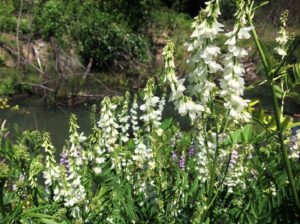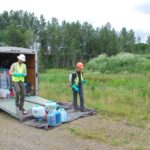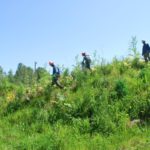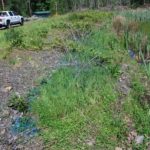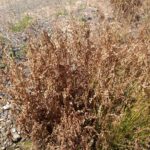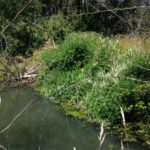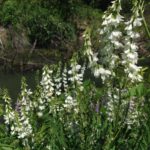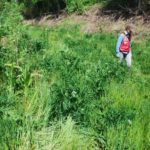Since 2016, the WeedWise program has been working to control the largest known infestation of goatsrue (Galega officinalis) in Oregon. Goatsrue is an Oregon class A noxious weed and has been deemed a high priority for control and eradication because it is toxic to livestock and spreads easily. This federal and state noxious weed is only known at a handful of other sites across Oregon and the Pacific Northwest.
About Goatsrue
Goatsrue is a deep-rooted perennial, with hollow stems and compound alternate leaves. The compound leaves have a terminal leaflet and 6-10 pairs of leaflets. The tip of each leaflet rapidly narrows to a fine tip. Goatsrue has pea-like flowers that vary in color from purple to white. Flowers bloom from June to October and are clustered at the end of its branches or at the leaf axils. Unlike some other members of the pea family, goatsrue lacks tendrils and grows in a more upright and bushy form rather than as a vine. The seeds are contained in pods with up to 9 mustard-colored, oblong seeds. Each plant can produce 15,000 pods a year. Additionally, these seeds may remain viable for 5-10 years in the soil.
Goatsrue closely resembles some regionally rare native plants, so we encourage landowners to contact us if they think they may have goatsrue on their property.
What we Found
In May of 2016, during one of our planned weed surveys, one of our contracted survey crews discovered a large population of goatsrue on two adjacent riparian properties along the Clackamas River. This infestation affects 14 acres and is the largest known infestation of goatsrue in Oregon. We quickly began a management effort to contain and control this priority weed with the goal of eradicating the goatsrue as well as several other priority invasive plants present at these sites.
This discovery was part of an extensive survey plan for streamside properties along the Clackamas River, initiated in 2015 and continuing into the present. Twenty-five priority invasive plant species are on our target list for these surveys. Some of these species have been documented in our region and some have not. These surveys are helping us to address new priority invasive plants and better manage priority invasive plants already established here. We thank private landowners for allowing us to access their properties for these surveys!
What we are doing
The WeedWise Program initiated control soon after detecting this large goatsrue infestation. Our approach began by confirming the identity of the plant. We then followed up with a thorough review of the biology of goatsrue. Most notably, we learned that goatsrue can have a long seed dormancy period allowing seeds to grow after 10 years in the soil. As a perennial weed with a deep taproot, it is also difficult to remove by hand. Therefore, our management goals were to prevent all seed production and to target the large root systems of existing plants.
Next, we researched management strategies appropriate for this plant and this site. We consulted with the Oregon Department of Agriculture Noxious Weed Control Program and the City of Portland Bureau of Environmental Services who both have prior experience managing goatsrue. Based on this research, we selected two herbicides to treat the infestation: one to target upland populations and a second aquatically-approved herbicide to treat infestations that occur near water. The herbicide applications were planned by the WeedWise program and implemented using licensed restoration contractors.
 What’s Next?
What’s Next?
To date, our management efforts have been highly successful, but with the size and complexity of the site, we noted new seedlings emerging, as well as some patches with regrowth after herbicide application. On follow-up monitoring visits, we also found several overlooked patches that had grown in an among other vegetation. In response, we have continued to scout for missed populations and have also removed interspersed invasive Himalayan blackberry (Rubus bifrons) stands which may hide goatsrue plants. We are carrying out multiple rounds of control each year to ensure that we are not letting any plants go to seed and to continue to address regrowth.
After two years of intensive control, we have dramatically reduced the populations and are on track to eradicate this population. Eradication will require ongoing monitoring and control to address the long seed dormancy. Although we won’t be walking away from the site anytime soon, we are optimistic, knowing that the population is significantly reduced, and that we are committed to eradicating goatsrue from Clackamas County!
Project Photo Gallery
- Goatsrue has pinnately compound leaves and an upright growth habit
- Goatsrure growing in drainage ditch
- Goatsrue growing along the edge of a small pond.
- Goatsrue growth habit
- Goatsrue growing in an opening within the floodplain of the Clackamas River.
- Professional weed control contractors were mobilized to control this large goatsrue infestation
- Goatsrue herbicide application
- Goatsrue herbicide application
- Goatsrue removed along pond
- Successfull goatsrue control
- Goatsrue regrowth after herbicide application
- Goatsrue growing along the bank of a beaver pond
- Goatsrue flowers
- WeedWise Specialist, Jeff Lesh pulling goatsrue (Galega officianalis) near the Clackamas River
- Goatsrue seedlings
- Goatsrue survey

